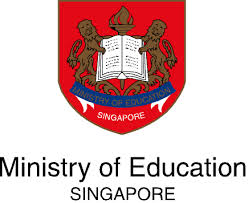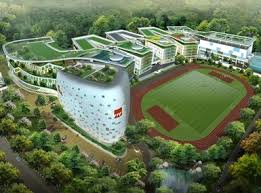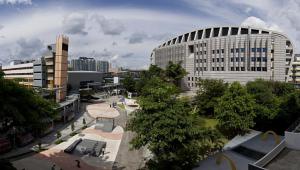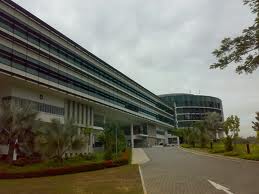Education in Singapore is managed by the Ministry of Education (MOE), which controls the development and administration of state schools receiving government funding, but also has an advisory and supervisory role in respect of private schools. For both private and state schools, there are variations in the extent of autonomy in their curriculum, scope of government aid and funding, tuition burden on the students, and admission policy.
Education spending usually makes up about 20 percent of the annual national budget, which subsidises state education and government-assisted private education for Singaporean citizens and funds the Edusave programme, the costs for which are significantly higher for non-citizens. In 2000 the Compulsory Education Act codified compulsory education for children of primary school age (excepting those with disabilities), and made it a criminal offence for parents to fail to enroll their children in school and ensure their regular attendance. Exemptions are allowed for homeschooling or full-time religious institutions, but parents must apply for exemption from the Ministry of Education and meet a minimum benchmark.
The main language of instruction in Singapore is English, which was officially designated the first language within the local education system in 1987. English is the first language learned by half the children by the time they reach preschool age and becomes the primary medium of instruction by the time they reach primary school. Although Malay, Mandarin and Tamil are also official languages, English is the language of instruction for nearly all subjects except the official Mother Tongue languages and the literatures of those languages; these are generally not taught in English, although there is provision for the use of English at the initial stages. Certain schools, such as secondary schools under the Special Assistance Plan (SAP), encourage a richer use of the mother tongue and may occasionally teach subjects in Mandarin Chinese. A few schools have been experimenting with curricula that integrates language subjects with mathematics and the sciences, using both English and a second language.
Singapore’s education system has been described as “world-leading” and in 2010 was among those picked out for commendation by the now-former British education minister Michael Gove.
( Primary School & Secondary School )
- Primary schools in Singapore are mainly classified as Government or Government-aided schools. Primary schools are typically mixed-sex, though there are a number of single-sex schools. Some primary schools are affiliated with a secondary school, and such schools may have a lower requirement for students from the primary section to enter the affiliated secondary school. Some primary schools are designated as Special Assistance Plan schools by the Ministry of education. These schools place a special emphasis on the learning of the Chinese language and culture.
- Autonomous schools have more autonomy as compared to other government-run secondary schools to plan their own curriculum and activities. However, such schools may charge a SGD$3 to SGD$18 miscellaneous fee on top of the regular school fees paid by all students attending government-run secondary schools. Independent schools are granted autonomy to design their own school curriculum as well as other school programmes. They are also allowed to choose their own students and set their own school fees. Their school fees are therefore usually higher than that of government-run schools,[citation needed] though such schools and the Ministry of Education offers some scholarships to offset the school fees.
The Institute of Technical Education is a post-secondary institution in Singapore that provides pre-employment training to secondary school leavers and continuing education and training to working adults. Established by Ministry of Education, it was formerly known as Vocational and Industrial Training Board (VITB). ITE has three colleges that offer the National ITE Certificate (NITEC), Higher NITEC, Master NITEC and diploma programmes.
( POLYTECHNIC )
The first polytechnic in Singapore, Singapore Polytechnic, was established in 1954. Ngee Ann Polytechnic, has roots that go back to 1963. Two other polytechnics, Temasek Polytechnic and Nanyang Polytechnic were set up in the 1990s The most recent, Republic Polytechnic was set up in 2003.
Polytechnics in Singapore provide 3-year diploma courses. They accept students based on their GCE “O” level, GCE “A” level or Institute of Technical Education (ITE) results. Unlike polytechnics in some other countries, they do not offer degree courses.
Polytechnics offer a wide range of courses in various fields, including engineering, business studies, accountancy, tourism and hospitality management, mass communications, digital media and biotechnology. There are also specialised courses such as marine engineering, nautical studies, nursing, and optometry. They provide a more industry-oriented education as an alternative to junior colleges for post-secondary studies. About 40% of each Secondary 4 cohort would enroll in Polytechnics.
Graduates of polytechnics with good grades can continue to pursue further tertiary education at the universities, and many overseas universities, notably those in Australia, New Zealand and the United Kingdom, give exemptions for modules completed in Polytechnic.
Polytechnics have also been actively working with many foreign universities to provide their graduates a chance to study niche University Courses locally. For example, Ngee Ann Polytechnic has engaged with Chapman University in the U.S. to provide a Bachelor of Fine Arts in Creative Producing for graduates of the School’s Film and Media Studies department. Nanyang Polytechnic, likewise, has tied up with the University of Stirling in Scotland to provide a course in Retail Marketing.
( JUNIOR COLLEGE )
Junior colleges in Singapore were designed to offer an accelerated alternative to the traditional three-year programme, but the two-year programme they offer has become the norm for students pursuing university education.
Junior colleges accept students based on their O-level results; an L1R5 (first language and five relevant subjects) score of 20 points or less must be attained for a student to gain admission. Junior colleges provide a 2-year programme leading up to the A-level examinations. The CI accepts students based on their GCE O-level results; an L1R4 (first language and four relevant subjects) score of 20 points or less must be attained for a student to gain admission. Millennia Institute provides a 3-year course leading up to the A-level examinations.
- Source: http://en.wikipedia.org/wiki/Education_in_Singapore





